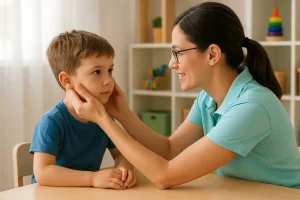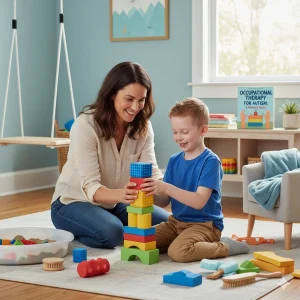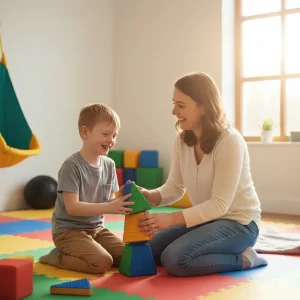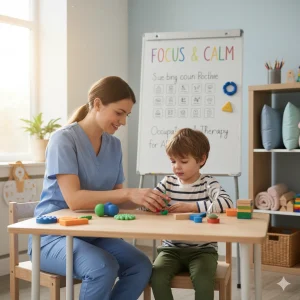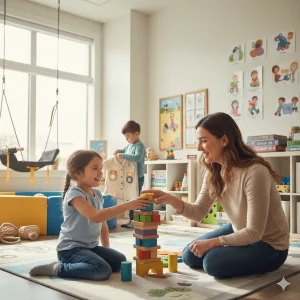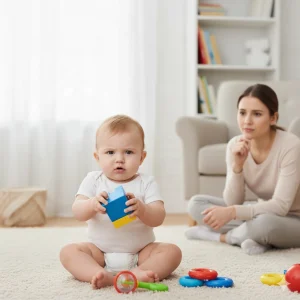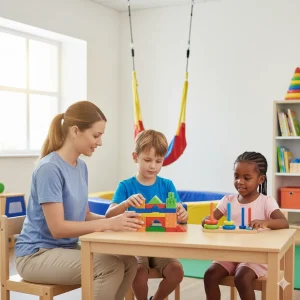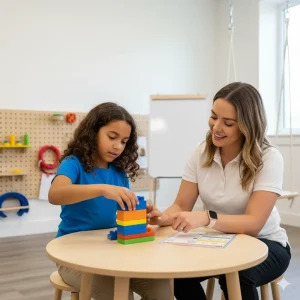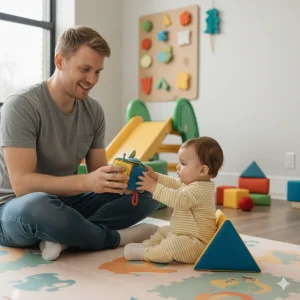How Occupational Therapy Empowers Children’s Communication
By Prapoorna M
Last Updated: February 29, 2024
Speech development in children is not just about learning to talk; it’s about opening a world of communication, connection, and learning. As parents and caregivers, witnessing the first words of a child is a moment filled with joy and anticipation. But what happens when a child faces challenges in this critical area of development? This is where the unique role of occupational therapy comes into play.
Occupational therapy, often associated with physical rehabilitation, holds a lesser-known yet significant role in aiding speech development in children. Unlike traditional speech therapy which directly targets speech and language skills, occupational therapy takes a holistic approach. It focuses on improving fine motor skills, sensory processing, and cognitive abilities, all of which are crucial foundations for effective speech and communication.
Also Read: What is the Relation between Communication, Speech and Language? | Speech and Language Therapy
Understanding Occupational Therapy for Speech Development
Occupational therapy might conjure images of physical rehabilitation, but its impact on speech development in children is a hidden gem in the therapeutic world. Distinct from traditional speech therapy, which directly addresses language skills, occupational therapy adopts a broader approach. It enhances various underlying skills necessary for effective speech and communication.
Occupational therapy for speech in children focuses on strengthening fine motor skills, sensory processing abilities, and cognitive functions. These foundational skills are crucial as they directly influence a child’s ability to articulate words, control their breathing while speaking, and even structure their thoughts into coherent sentences. For instance, a child with improved fine motor skills may find it easier to form words, while better sensory processing can help them understand and respond to verbal cues more effectively.
Techniques Used in Occupational Therapy for Speech Enhancement
Playful Learning
One of the most effective strategies used in occupational therapy is incorporating play into learning. Play is a natural activity for children and offers an enjoyable way to develop speech and language skills. For example, a game of “Simon Says” not only provides fun but also enhances listening skills and the ability to follow verbal instructions. Similarly, engaging in imaginative play, like pretending to be on a space mission, encourages children to articulate their thoughts and expand their vocabulary in a creative setting.
Learn more about on Speech Therapy at Home: Top Tips For Parents
Utilizing Visual Aids
Visual aids and props are powerful tools in occupational therapy for speech development. These aids help children make connections between objects and their corresponding names or descriptions. For example, using picture cards during therapy can help a child associate an image of an apple with the word ‘apple’. This visual connection reinforces learning and aids in memory retention, making speech development more interactive and effective.
Know more about Visual Communication and Autism: The Power of Visual Schedules
Personalizing Therapy
Every child is unique, with individual interests and learning styles. Tailoring occupational therapy to fit these personal interests can significantly boost engagement and results. For instance, if a child is fascinated by animals, incorporating animal-themed activities into therapy sessions can make learning more relevant and exciting for them. This personal touch not only makes the therapy sessions more enjoyable but also fosters a deeper connection and understanding, paving the way for more effective speech development.
Read more The Effect of Colors in Autistic Children
Key Differences: Occupational Therapy vs. Traditional Speech Therapy
| Factor | Occupational Therapy | Traditional Speech Therapy |
|---|---|---|
| Primary Focus | Holistic development includes motor skills, sensory processing, and cognitive functions. | Directly targets speech and language skills. |
| Techniques Used | Playful learning, sensory integration, motor skill activities, and use of technology. | Articulation exercises, language drills, phonetics training, and fluency enhancement. |
| Goals | Improve underlying cognitive and motor functions to aid in speech development. | Enhance speech clarity, language comprehension, and communication abilities. |
| Treatment Approach | Broad-based approach addressing various developmental aspects that contribute to speech. | Specific approach focusing on correcting speech and language-related issues. |
| Role of Therapist | Guide and support overall development to indirectly improve speech. | Directly work on speech and language improvement. |
| Parental Involvement | Parents are engaged in understanding and supporting a wide range of developmental activities. | Parents are often given specific speech and language exercises to practice at home. |
| Tool Utilization | Uses a variety of tools including games, sensory activities, and technology aids. | Primarily uses verbal exercises, phonetic tools, and articulation activities. |
| Outcome Measurement | Progress is measured in terms of overall development and functionality. | Progress is specifically measured in speech clarity and language use. |
| Ideal for Children with | Broader developmental delays or sensory processing disorders. | Specific speech or language disorders. |
| Session Environment | Often playful and varied, depending on the child’s needs and interests. | Structured around speech and language activities. |
Explore more on Engaging Home-Based Occupational Therapy Activities for Children with Autism
Home Strategies to Support Speech Development
Supporting a child’s speech development extends beyond the therapist’s office. Parents and caregivers can play a pivotal role in reinforcing the progress made during occupational therapy sessions. Utilizing simple, at-home techniques not only complements professional therapy but also provides a nurturing environment conducive to learning and growth.
Conversation and Storytelling:
Engaging in everyday conversations or storytelling can significantly enhance your child’s language skills. Simple activities like describing your day or creating a story together encourage your child to form sentences and express their thoughts. This practice aligns perfectly with the communicative aspects emphasized in occupational therapy.
Flashcards and Picture Books:
Visual aids like flashcards or picture books are excellent tools for building vocabulary. Identifying objects and describing scenes in picture books can help your child make connections between words and their meanings, mirroring the visual techniques used in therapy sessions.
Silly Sounds and Mimicry:
Embrace the fun side of learning by making silly sounds or playing mimicry games. These activities not only make learning enjoyable but also improve your child’s ability to articulate different sounds, a key aspect of occupational therapy for speech development.
Regular Reading Time:
Allocating time for reading with your child every day can do wonders. This activity enhances language comprehension and vocabulary, supporting the goals set in occupational therapy.
Also Read: Understanding Speech Delay: Causes, Milestones, and Therapy
At-Home Occupational Therapy Activities
| Activity | Description | Speech Development Goal |
|---|---|---|
| Storytelling | Engage in creating and narrating stories with your child. This can be about daily events, imaginary tales, or based on a book. | Enhances narrative skills, vocabulary expansion, and sentence structuring. |
| Flashcard Fun | Use flashcards with images and words. Show the card and pronounce the word, encouraging your child to repeat it after you. | Aids in word recognition and vocabulary building. |
| Silly Sounds Game | Make and imitate different sounds together, like animal noises or funny voices. | Improves articulation and phonemic awareness. |
| Mirror Mouth Movements | Sit with your child in front of a mirror and practice making different mouth movements. Say a word and show how your mouth moves, then have your child imitate. | Enhances awareness of how to form words and sounds correctly. |
| Finish My Sentence | Start a sentence and let your child finish it. For example, “We went to the park and saw a…” | Encourages creative thinking and sentence completion, improving expressive language. |
| Role-Playing | Engage in role-playing activities, like pretending to be different characters, which involve dialogues and interaction. | Enhances social communication skills and imaginative use of language. |
| Sing-Along Sessions | Sing songs together, especially those with repetitive and rhyming lyrics. | Encourages rhythm and pattern recognition in speech, improving fluency. |
| Picture Book Reading | Read picture books together, discussing the images and story. Ask questions about the story to encourage your child to express their thoughts. | Builds vocabulary, and comprehension, and encourages descriptive language use. |
| Emotion Cards | Use cards showing different emotions. Have your child describe what each emotion is and when they might feel that way. | Improves emotional literacy and expressive language related to feelings. |
| Treasure Hunt | Organize a simple treasure hunt with verbal or picture clues leading to a hidden object. | Enhances comprehension, problem-solving, and following multi-step directions. |
Success Stories and Real-World Applications
Hearing about the success of others can be incredibly motivating. While we respect the privacy of our clients at Wellness Hub, we can share some generic success stories that mirror the experiences of many families.
Case Study 1:
A young boy, initially struggling with articulation difficulties, found his voice through a combination of occupational therapy and home-based activities. His parents played a crucial role by integrating fun speech games and regular reading sessions at home. Over time, his confidence and ability to express himself improved remarkably.
Case Study 2:
Another child, facing challenges with expressive language, benefited greatly from personalized occupational therapy. Tailored activities that aligned with her interests, combined with supportive strategies at home, led to significant improvements in her communication skills.
Also Read: Speech and Language Milestones: 0 to 12 Months
The Role of Technology and Social Interaction
In this era of digital innovation, technology has become a vital ally in occupational therapy, especially for speech development in children. Interactive apps and educational games have opened new avenues for engaging young minds in speech exercises. These digital tools are designed to make learning not only more fun but also more effective, appealing to the tech-savvy generation of today.
Apps for Speech Development:
Many apps are available that focus on speech and language skills. They range from simple word games to more complex storytelling exercises, all tailored to enhance a child’s speech capabilities. The beauty of these apps is that they provide immediate feedback, a key factor in learning, and can be customized to suit the individual needs of each child.
Educational Games:
Games designed for tablets or computers offer a dynamic way of practicing speech. They often include elements of phonetics, vocabulary building, and sentence formation, making them a perfect complement to traditional therapy methods. Plus, the interactive nature of these games keeps children engaged and motivated.
Social Interaction in Therapy:
Alongside technology, social interaction plays a pivotal role in speech development. Group activities and play sessions in occupational therapy settings provide children with opportunities to practice their communication skills with peers. This interaction is crucial as it helps children learn how to use language in social contexts, understand non-verbal cues, and develop listening skills.
Explore more about on The Role of Eye Contact in Your Child’s Speech and Language Development
Involving Parents in the Process
The journey of speech development doesn’t end in the therapist’s office. Parental involvement is crucial in reinforcing the skills learned during therapy sessions. Parents can play a significant role in their child’s progress by integrating speech therapy techniques into daily routines at home.
Integrating the Tips for Parenting an Autistic Child? | Helping Your Child with Autism
Strategies for Parents:
- Daily Conversation: Engage your child in regular conversations. Talk about your day, ask about theirs, and encourage them to express their feelings and thoughts.
- Reading Together: Set aside time for reading together. Choose books that are age-appropriate and discuss the story to improve comprehension and vocabulary.
- Incorporate Play: Use playtime as an opportunity to practice speech. Narrate your actions and encourage your child to do the same.
- Consistency is Key: Consistency in practicing these techniques is crucial. Make them a fun and regular part of your daily routine.
Accessing Services and Overcoming Challenges
Overcoming Common Challenges:
- Patience and Persistence: Speech development can be a slow and gradual process. It’s important to be patient and persistent. Celebrate small victories and progress, no matter how minor they may seem.
- Consistency: Consistent practice is key. Whether it’s exercises at home or regular therapy sessions, maintaining a routine helps reinforce learning and development.
- Family Involvement: Encourage family members to be part of the process. Their support and involvement can significantly contribute to your child’s progress.
- Adapting Techniques: If certain techniques aren’t working, don’t be afraid to adapt. Occupational therapists can tailor their approaches to better suit your child’s unique needs and learning style.
- Emotional Support: Acknowledge that this journey can be emotionally challenging. Seek support from therapists, support groups, or other parents going through similar experiences.
Common Speech Development Challenges and Solutions
| Challenge | Occupational Therapy Solution | Tips for Parents |
|---|---|---|
| Articulation Difficulties | Use of targeted speech exercises to improve the clarity of speech sounds. | Practice specific sounds with your child daily; be patient and provide positive reinforcement. |
| Limited Vocabulary | Engaging in activities that introduce new words in meaningful contexts. | Read diverse books together and discuss new words; encourage your child to describe their day. |
| Stuttering | Implementing fluency-enhancing strategies and stress-reduction techniques. | Speak slowly and calmly with your child; avoid finishing their sentences for them. |
| Difficulty Understanding Instructions | Utilizing simple, structured tasks to improve comprehension. | Break down instructions into smaller, manageable steps; use visual aids when possible. |
| Expressive Language Delay | Activities that encourage the child to express their thoughts and needs. | Engage in open-ended play and ask open-ended questions to stimulate conversation. |
| Social Communication Challenges | Role-playing and group activities to improve interaction skills. | Arrange playdates or group activities; model appropriate social interactions. |
| Difficulty with Phonemic Awareness | Phonics games and activities that focus on sound recognition. | Play sound-matching games; use rhymes and songs to enhance phonemic awareness. |
| Problems with Voice Quality | Exercises to improve breath control and vocal cord function. | Encourage singing and use of voice modulation games; monitor voice use to prevent strain. |
| Difficulty with Non-Verbal Communication | Training in understanding and using body language and facial expressions. | Practice recognizing emotions through facial expressions; use role-playing to understand non-verbal cues. |
| Lack of Motivation to Communicate | Incorporating the child’s interests into speech activities to boost engagement. | Find out what interests your child and use it to initiate conversation and activities. |
Choose How to find the right Autism therapy center for my child?
Conclusion
As we’ve journeyed through the intricacies of occupational therapy and its pivotal role in enhancing speech development in children, a few key points stand out. Firstly, occupational therapy offers a unique, holistic approach that goes beyond traditional speech therapy, focusing on overall development to aid speech. Techniques such as playful learning, utilizing visual aids, and personalizing therapy are instrumental in making this process engaging and effective for each child.
We also delved into the critical role of technology and social interaction in modern therapy settings, highlighting how they complement traditional methods. Moreover, the importance of family involvement cannot be overstated. Parents and caregivers are not just observers but active participants in nurturing their child’s speech development, using strategies that can easily be integrated into daily routines.
As every child’s journey is unique, facing challenges and celebrating milestones along the way, remember that persistence, patience, and consistent practice are key. For families looking for guidance, support, or simply exploring options for occupational therapy in speech development, Wellness Hub stands ready to assist. Our team of dedicated professionals is committed to providing personalized care and strategies tailored to each child’s needs.
Frequently Asked Questions:
1. What is occupational therapy for speech in children?
Occupational therapy for speech development in children is a holistic approach that focuses on enhancing various skills like fine motor, sensory processing, and cognitive abilities, which are essential for effective speech and communication.
2. How does occupational therapy differ from traditional speech therapy?
Unlike traditional speech therapy which targets speech and language skills directly, occupational therapy takes a more comprehensive approach. It works on underlying skills that contribute to speech, such as motor skills and sensory processing, offering broader developmental support.
3. Can I practice occupational therapy techniques at home with my child?
Yes, there are several techniques that can be practiced at home to complement occupational therapy. These include engaging in conversation and storytelling, using flashcards and picture books, and incorporating play into learning.
4. Are there any technology-based tools recommended for speech development in children?
Yes, there are various apps and educational games designed to enhance speech and language skills in children. These interactive tools make learning more engaging and can be a valuable addition to traditional therapy methods.
5. Why is social interaction important in occupational therapy for speech development?
Social interaction is crucial in occupational therapy as it provides children with opportunities to practice their communication skills in real-life settings. It helps in understanding and using language within a social context, enhancing overall speech development.
6. How can parents support their child’s speech development through occupational therapy?
Parents can support their child’s speech development by integrating occupational therapy techniques into daily routines, engaging in regular conversations, reading together, and being consistent with practice at home.
7. What are common challenges in speech development and how can they be overcome?
Common challenges include slow progress, difficulty in articulation, and limited vocabulary. These can be overcome through consistent practice, patience, and adapting techniques to suit the child’s unique needs.
8. How can I find the right occupational therapist for my child?
Finding the right occupational therapist involves researching local services, evaluating specializations, checking credentials, and considering insurance and cost factors. Consultations are also important to ensure the therapist’s approach aligns with your child’s needs.
9. Can occupational therapy help with other developmental issues besides speech?
Yes, occupational therapy can help with a range of developmental issues including motor skills, sensory processing, cognitive skills, and social-emotional development.
10. How can Wellness Hub assist in my child’s speech development through occupational therapy?
Wellness Hub offers personalized occupational therapy services focused on speech development. Our team of skilled professionals works closely with each child and their family to develop tailored strategies that address individual needs and goals.
About the Author:
Prapoorna Mangalampalli
M.Sc., M.A., (Dual Masters in Psychology & English) – Counselor (6+ years of experience)
Prapoorna armed with a passionate dedication fueled by dual Master’s degrees in Psychology and English, Prapoorna sheds light on and elevates human experiences. Over 6+ years of experience fuel her insightful approach to counseling, offering profound empathy and guidance across diverse areas like online, marital, relationship, child, family, and career counseling. This dedication to empowering positive change is further underscored by her specialized training in various counseling sectors.
Currently, at Wellness Hub, she thrives in a team environment that values innovation, compassion, and achieving results for their clients.
Connect with Prapoorna to learn more about how she can help you or your loved one find their voice and build a brighter future.
Book your Free Consultation Today
Parent/Caregiver Info:
Client’s Details:
* Error Message
